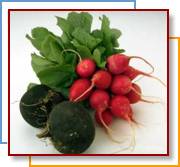 |
|
|
National Center for Chronic Disease Prevention and Health Promotion
Home | About Us | Site Map | Topic Index | Contact Us
|
||||||||
National Center for Chronic Disease Prevention and Health Promotion Home | About Us | Site Map | Topic Index | Contact Us |
||||||||
|
Vegetable of the MonthRADISH!
Radishes were first cultivated thousands of years ago in China, then in Egypt and Greece. Radishes were so highly regarded in Greece that gold replicas were made. The radish did not make its way to England until approximately 1548. By 1629 they were being cultivated in Massachusetts. Radishes are root vegetables that resemble beets or turnips in appearance and texture, but have a distinct flavor. It is the root of a plant classified in the mustard family. In the United States radishes are usually eaten raw; however, they can be added to cooked dishes or served whole. The biggest crops grown in the United States come from California and Florida, but most states grow radishes.
|
|
|
 Radish Celery Salad
Radish Celery Salad
3 servings, each serving equals two 5 A Day
servings
Source: unknown
Ingredients
1 cup Radishes;
1 cup Celery; sliced thin
1 cup Lettuce leaves; torn up
Toss radishes, celery, and lettuce together. Top with your favorite low or no-fat dressing. (NOTE: dressing is NOT included in the nutritional analysis below.)
Nutritional analysis per serving: Calories 15, Fat 0g, Protein 1g, Fiber 45g, Carbohydrate 3g, Cholesterol 0mg, Sodium 45mg.
East Meets West Daikon Salad
2 servings, each serving equals one 5 A Day
serving
Source: unknown
Ingredients
10 oz daikon radish
3 Tbsp mayonnaise
½ Tbsp soy sauce
¼ – ½ teaspoon mustard powder (any kind, but sharper is better)
1 12.5 to 13 oz can of tuna, packed in wate
1. Cut daikon into matchstick-sized pieces and place in strainer.
2. Mix daikon with the tuna. Combine mayonnaise, soy sauce and mustard
powder in a bowl and then fold into the daikon salad.
Nutritional analysis per serving: Calories 272, Fat 7g, Calories from Fat 22%, Protein 43g, Cholesterol 55mg, Carbohydrate 9g, Fiber 2g, Sodium 925mg.
 Daikon Salad
Daikon Salad
Serves 4, each serving equals one and half 5 a Day
servings
Source: unknown
Ingredients
2 cups daikon/white asian radish, peeled and grated
1 cup carrot, peeled and grated.
½ tsp sugar, or more to taste.
1 tsp oil, olive
2 tsp lemon juice, fresh
salt, to taste.
Gently squeeze out some but not all the liquid from the radish. Place
in a salad bowl.
Add the carrot, ½ tsp of sugar, oil, and lemon juice and toss. Season with
salt and add more sugar, if desired. Cover and refrigerate for at least 30
minutes.
Nutritional analysis per serving: Calories 48, Fat 2g, Calories from Fat 27%, Protein 1g, Carbohydrates 3g, Fiber 3g, Sodium 328mg.
Radish Soup
Serves 4, each serving equals two 5 A Day servings
Source: Radish Council
Ingredients
5 cups chicken stock
¼ cup rice vinegar
2 Tbsp sugar
¼ tsp cayenne pepper
¼ tsp ground (dried) ginger
1 pound raw shrimp, peeled and deveined
1½ cups sliced radishes,
1½ cups spinach leaves, shredded
1 cup thinly sliced green onions
In a large saucepan over medium heat, bring stock to a boil. Stir in vinegar, sugar, cayenne and ginger. Add shrimp and cook until shrimp turn pink and curl, about 3-4 minutes. Turn off heat, stir in radishes, spinach and green onions. Cover and let stand 2-3 minutes before serving.
Nutritional analysis per serving: Calories 371, Fat 6g, Calories from Fat 13%, Protein 39g, Carbohydrates 41g, Cholesterol 41mg, Fiber 5g, Sodium 1263mg.
 Roasted Radishes and Root Vegetables
Roasted Radishes and Root Vegetables
Serves 4, each serving equals four 5 A Day
servings
Source: Radish Council
Ingredients
3 medium sweet potatoes, peeled and cut into 2-inch chunks (3 cups)
4 medium parsnips, peeled and cut into 2-inch, about 2 cups
2 medium red onions, peeled and quartered
12 oz. radishes
1 whole head of garlic, cut in half lengthwise
3 tablespoons olive oil
½ tsp. black pepper
1 Tbsp or 1 tsp dried thyme
Preheat oven to 450 F. In a 13x9x2 inch nonstick baking pan (or spray a conventional pan with vegetable cooking spray) place mushrooms, bell pepper, zucchini and onion. Toss with olive oil, garlic, salt and black pepper. Bake uncovered, until mushrooms and vegetables are tender, about 20 minutes. Serve as a side dish, or toss with pasta or rice if desired.
Nutritional analysis per serving: Calories 342, Fat 8g, Calories from Fat 22%, Protein 3g, Cholesterol 0mg, Fiber 5g, Sodium 300mg.